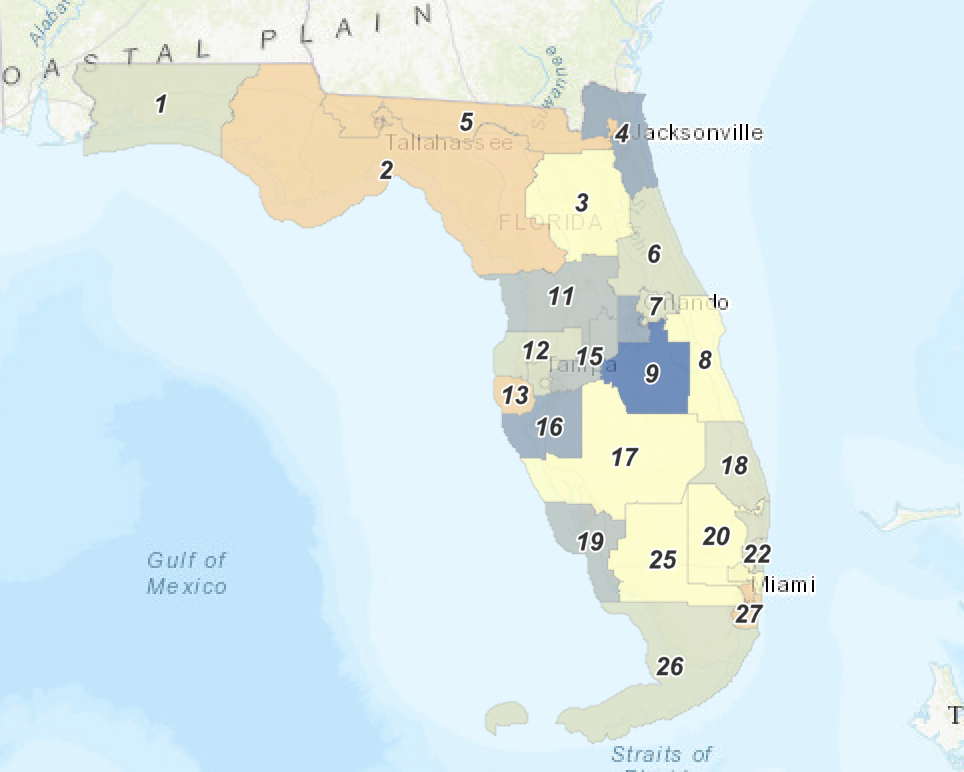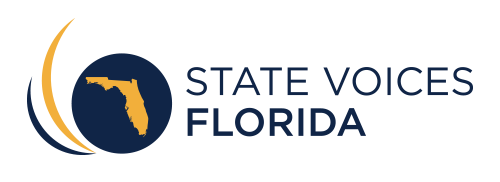
Floridians across the state are hearing a lot about redistricting. If you’re not sure what it is, and its significance in the fight for a healthy democracy and political power for Black people, Indigenous people, and other people of color, you’re in the right place.
Every ten years, congressional, state, and local district maps are redrawn based on the new census data on the population. Believe it or not, this reapportionment of political representation heavily impacts our communities’ ability to fight for equity and justice.
Redistricting is critical in ensuring that every community, every voice, and every vote is heard equitably. And fair community districting will make it easier for the countless diverse voters of Florida to build power and expand access to resources in our communities.
So, why has redistricting become such a controversial issue in the past few decades? In many cases, politicians will use gerrymandering tactics to draw district maps to their political advantage.
Check out these ten things to know about Florida’s redistricting process and how gerrymandering impacts your community.
- Community districting determines who represents us and how state resources are allocated.
Redistricting, sometimes referred to as community redistricting, is based on the idea of “one person, one vote”, which ensures that each of our voices can be represented fairly by creating districts with the same number of people.
How district lines are drawn influences who runs for public office and who is elected. Elected representatives make important decisions in our lives, from ensuring safe schools to adopting immigration policies. Who lives in a district can influence whether elected officials feel obligated to respond to a community’s needs.
The district boundaries are in place for the next ten years, and their policy impacts can last well beyond that.
You can find out who represents your district by using the Common Cause tool.
- Census population data informs the community districting process.
Census data collected every ten years is used to draw new maps to account for how populations have changed and moved across the states and districts.
Just as the 2020 Census will impact federal funding for the next ten years, community districting will determine community representation for the next decade.
The Census Bureau released current census data this past year. Explore how state populations have shifted over the last decade here.
- How redistricting works in Florida.
In Florida, our state legislators draw our district maps. This was initially intended to ensure that districts are equal in population and that every person has equal representation.
When it comes to congressional redistricting, lines are adopted as regular legislation and are subject to gubernatorial veto, while state legislative lines are passed via joint resolution and are not subject to gubernatorial veto.
State legislative district maps are automatically submitted to the Florida Supreme Court for approval. If the court rejects the lines, the legislature is given a second chance to draft a plan. If the legislature cannot approve a state legislative redistricting plan, the state attorney general must ask the state supreme court to draft a plan.
- Fair community districting can prevent politicians from packing and dividing our communities, and you can help advocate for fair districts.
Certain politicians have historically drawn maps in ways that pack or divide communities of color and silence their collective power.
This practice is called gerrymandering, and the result is diluted voting power of Black and POC communities.
The harmful practice of gerrymandering started in the 1800s when the Governor of Massachusetts Elbridge Gerry carved up a district that resembled a salamander. He drew the district in this way to favor his political party and hoard power.
In an effort to prevent Florida legislators from drawing lines favoring political parties or incumbents, statewide Fair Districts amendments in 2010 was put on the ballot for a vote. The amendments were supposed to end the longstanding practice by ruling parties in the Legislature —Democrats, then Republicans — of creating as many voter-friendly districts for their candidates as possible. Voters overwhelmingly supported these initiatives with 63% of the vote.
While these amendments are still in effect, legal challenges to Florida’s past maps by the League of Women Voters have worked to enforce these Fair District principles.
Through public testimony and monitoring of the process, communities can ensure that future maps better represent all people. To ask your state legislators to enforce fairly drawn districts, send your representative a personalizable email requesting that they sign on to the Fair Districts pledge.
Groups like the ACLU-FL, League of Women Voters of Florida, Florida Conservation of Voters, and other trusted partners regularly monitor gerrymandered maps in Florida and when needed, work together to file litigation. You can learn more about recent and ongoing cases here.
- Our network is working to create fair districts for everyone—including people who are incarcerated.
Prison gerrymandering is the practice of counting people who are incarcerated at the places where they are imprisoned rather than as part of their home community.
Incarcerated people are often sent to prisons far away from their homes, and most prisons are in predominantly white areas. In the Census, incarcerated people are counted as residents of where they are imprisoned, instead of their homes. Since prisons are concentrated in white areas and Black people are disproportionately imprisoned, prison gerrymandering leads to higher Census counts in white areas and lower counts in Black areas.
This impacts political representation, like the number of representatives an area gets, if states fail to adjust their population data to ensure equitable community districting.
According to the NAACP Legal Defense Fund, African Americans are 12.7% of the general population, but represent 41.3% of the federal and state prison population. The practice of prison gerrymandering increases the political representation in white counties while removing representation from Black counties.
Many states—including Washington, Colorado, Nevada, and Virginia—have successfully passed prison gerrymandering reform and will now count incarcerated people in their home communities. This reform ensures that representation is more accurate and ends the unfair extraction of people, resources, and representation from BIPOC communities.
The Prison Policy Initiative has worked closely with State Voices National affiliates to create reform legislation and local-level solutions. Learn more about the problem and ways to create solutions.
- Nationwide and state-based coalitions are fighting for fair community districting processes.
Coalitions across the country are calling for more transparency and public participation during redistricting hearings. State Voices Florida leads local redistricting efforts for the Fair Districts Coalition where we provide training for advocates across the state on the local level.
If you want to get involved, contact our team for more information on local redistricting efforts and advocacy opportunities.
- The outcomes of community districting will impact states and localities for the next decade.
Similar to the decennial census, community districting done in 2021 and 2022 will have a lasting impact on state elections and legislative advocacy work.
The new lines that will be drawn to account for demographic shifts and population growth in the last ten years will directly affect who has political power in the next ten years.
This will in turn affect what issues legislatures choose to tackle, and which they ignore. Through new or expanded representation, communities can organize to fight for things like police reform, education, healthcare, or other needed services.
- What does Redistricting Look Like In Florida?
Having gained a 28th congressional district, and with one party in full control of state government, Florida went into this redistricting cycle as one of the biggest opportunities for the party in leadership to gain seats.
Currently, the state Senate’s eight proposed maps would create 14 Republican-leaning seats and eight Democratic-leaning seats (same as the current map) as well as six highly competitive seats (one more than the current map).
The state House’s two proposed maps are more partisan: They have efficiency gaps of R+10 and R+13, and the median seat of both maps is 5 points more Republican-leaning than the state as a whole. These maps would create 15 Republican-leaning seats, eight or nine Democratic-leaning seats and four or five highly competitive seats.
For a complete breakdown on the proposed maps, check out the Princeton Redistricting Project.
Sources: https://voicesforpower.statevoices.org/9-things-to-know-about-redistricting/
